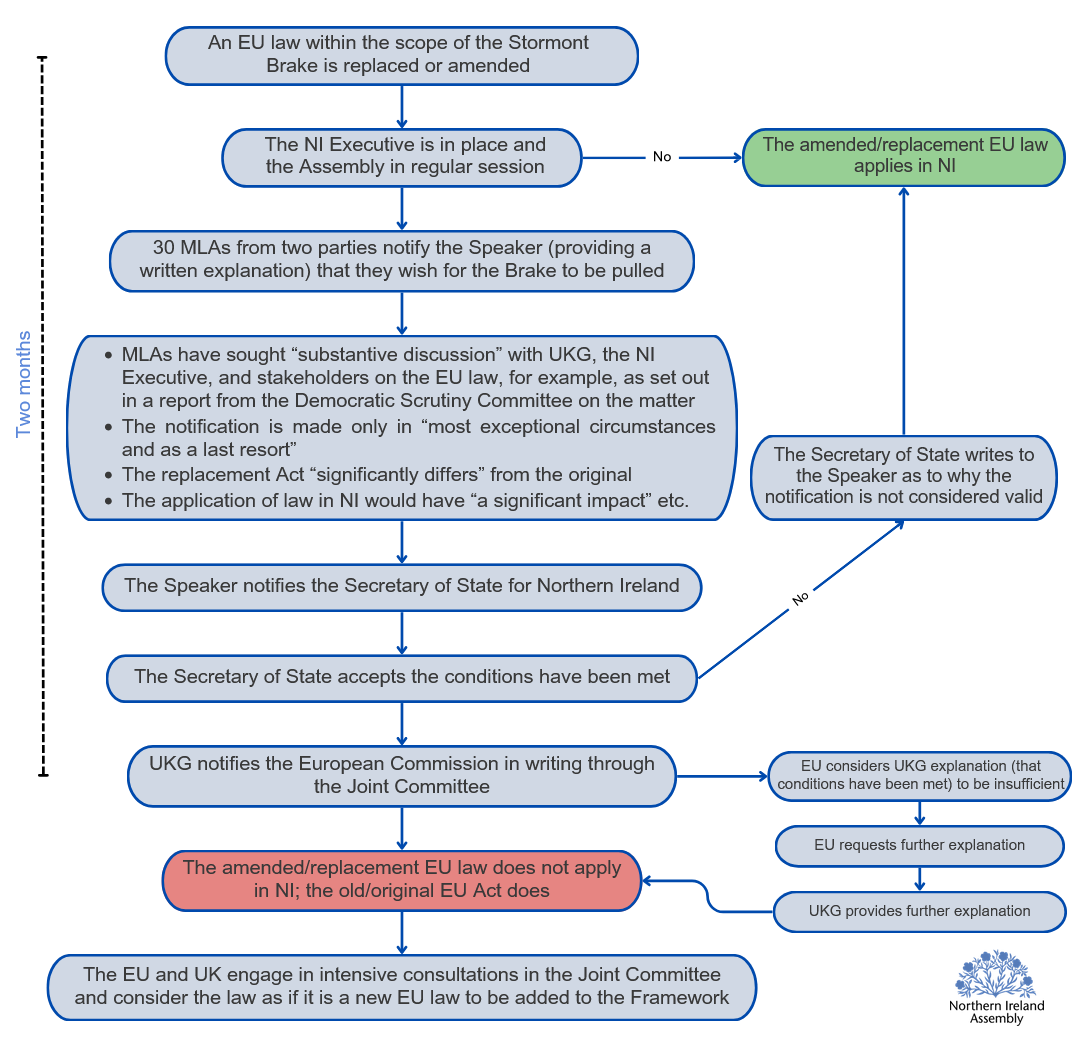The Stormont Brake
Read an explainer on the Stormont Brake.pdf (357.89 kb)
The Windsor Framework was agreed in March 2023 and introduced a new mechanism, the Stormont Brake, which the UK Government calls “a powerful new democratic safeguard”.
The Stormont Brake may apply to an EU act, which amends or replaces an act which already applies in Northern Ireland under the Windsor Framework. Applicability motions apply when the EU adopts a new act, which it considers to be within the scope of the Windsor Framework.
The Stormont Brake process
Under the terms of the Stormont Brake, 30 MLAs from at least two parties in the NI Assembly can notify the UK Government of their wish that the “emergency brake” on EU law be pulled i.e. that they wish to stop the application of amended or replacement EU law in Northern Ireland.
There are restrictions on its use:
- The Northern Ireland Executive must be operational and the NI Assembly in regular session
- The MLAs who wish to pull the Brake must explain:
- how the notification is being made in “the most exceptional circumstances and as a last resort, having used every other available mechanism”
- how the content or scope of the amended or replaced EU law “significantly differs” from the original law; and its application “would have a significant impact specific to everyday life of communities in Northern Ireland in a way that is liable to persist”
- that they have “sought prior substantive discussion with the UK Government and within the Northern Ireland Executive to examine all possibilities in relation to the Union act; taken steps to consult businesses, other traders and civic society affected by the relevant Union act; and made all reasonable use of applicable consultation processes provided by the European Union for new Union acts relevant to Northern Ireland”
Then, if the UK Government is satisfied that the above conditions have been met, it will notify the EU in the Joint Committee. This notification must be made within two months following the publication of the EU law and include a “detailed explanation” of the UK’s assessment regarding the conditions set out above. If the EU thinks the UK’s explanation is “insufficient”, it can request further information from the Government.
The EU law will not apply in Northern Ireland in its new form two weeks later. The older version of the EU law will still apply.
At this stage, the relevant law is then discussed in the EU-UK Joint Committee under the process for new EU laws - Article 13(4) of the Windsor Framework. The UK Government must not agree (apart from in exceptional circumstances) to adopt the new law unless the Assembly has passed a motion with cross-community support, known as an applicability motion. If no applicability motion has been passed, the Government may agree to the law applying in Northern Ireland if there are “exceptional circumstances” or the law “would not create a new regulatory border between Great Britain and Northern Ireland.”
The Stormont Brake process is set out in the diagram below*:
At the final stage, the process moves to that set out in Article 13(4). Click here for information on applicability motions.
Legal texts and operational details
- A decision of the Withdrawal Agreement Joint Committee makes provision for the Stormont Brake in Article 13(3a). The decision includes a unilateral declaration by the UK Government setting out the procedure and conditions.
- The UK Government made the Windsor Framework (Democratic Scrutiny) Regulations 2024, which contains additional details about the Stormont Brake procedures, and establishes the Windsor Framework Democratic Scrutiny Committee.
- In February 2024, the UK Government published a letter to the Speaker with additional details about information on EU acts to be provided to the Assembly, and the operation of the Stormont Brake.
- In February 2024, the UK Government made the Windsor Framework (Constitutional Status of Northern Ireland) Regulations 2024, which amend section 7A of the European Union (Withdrawal) Act 2018 to reflect the Stormont Brake. Section 7A provides the mechanism for certain EU laws to be given legal effect in the UK.
*This flowchart summarises the process. It should be read in conjunction with the relevant legislation and documents set out above.



